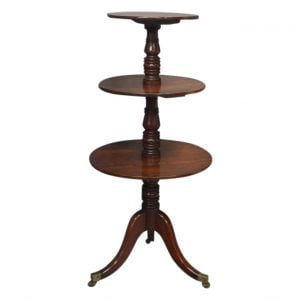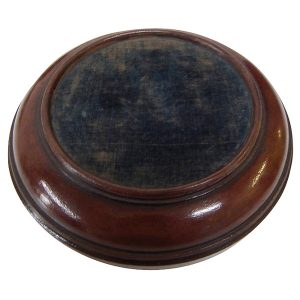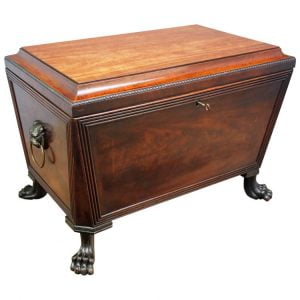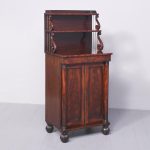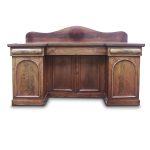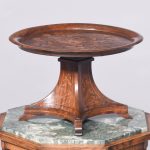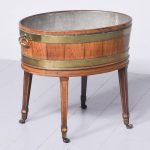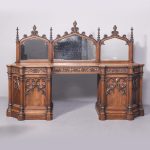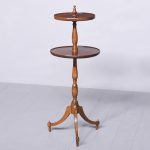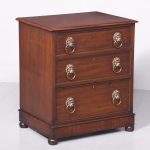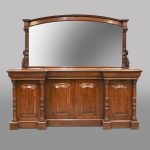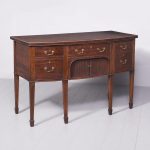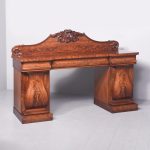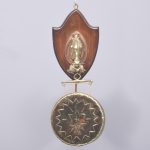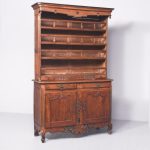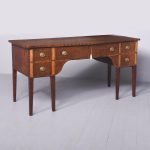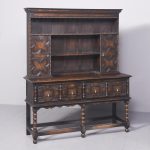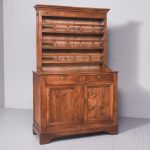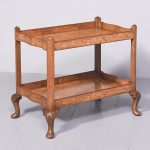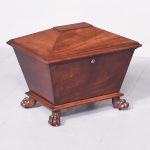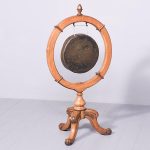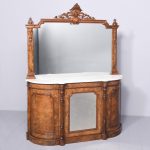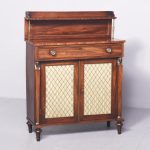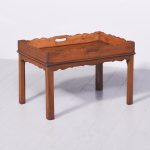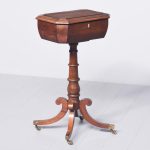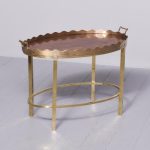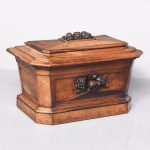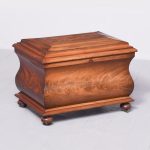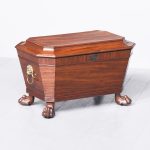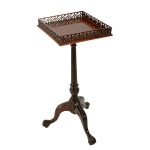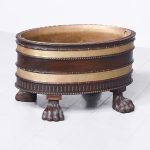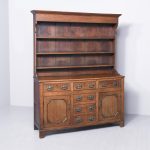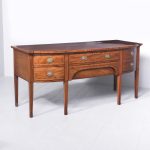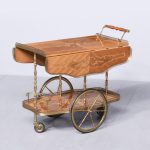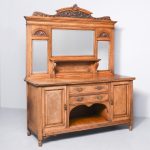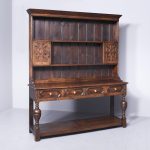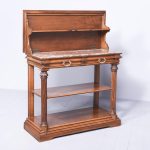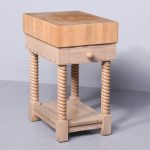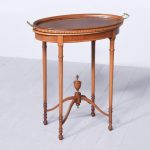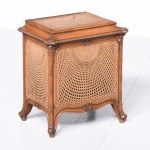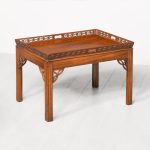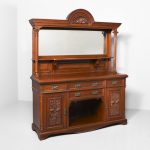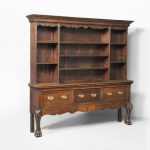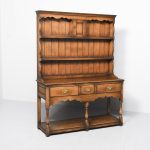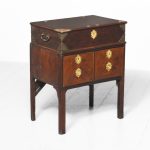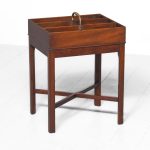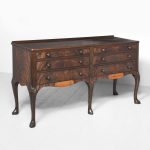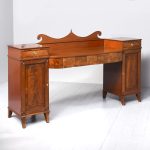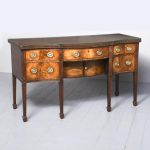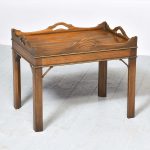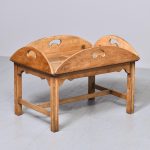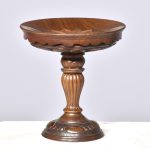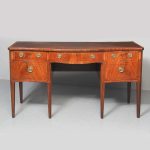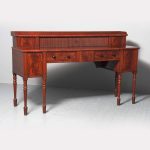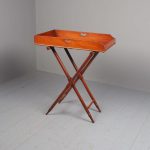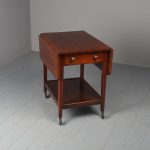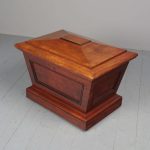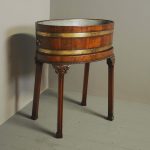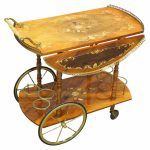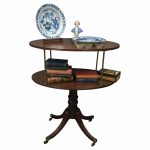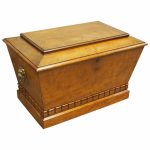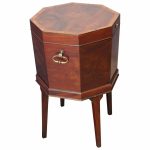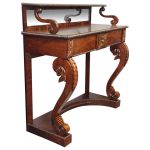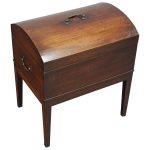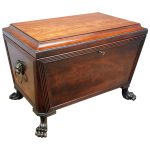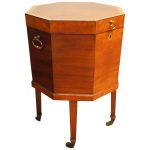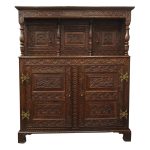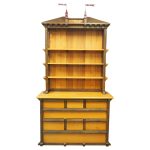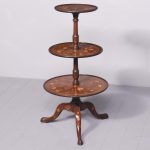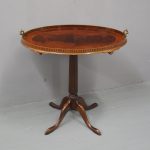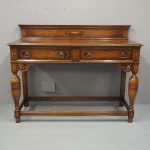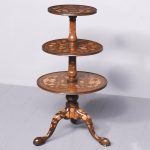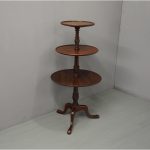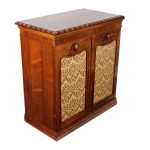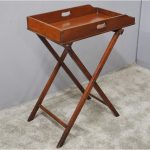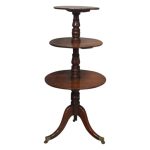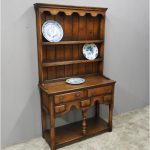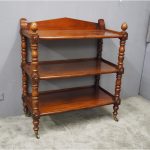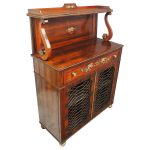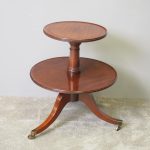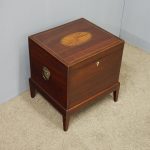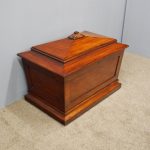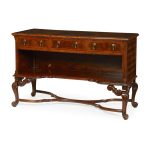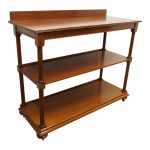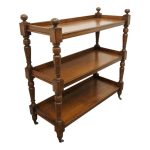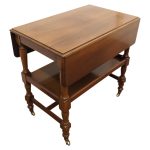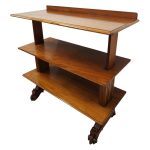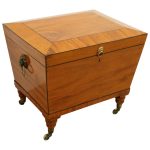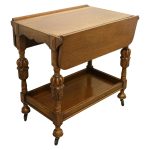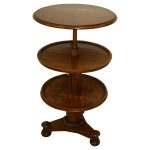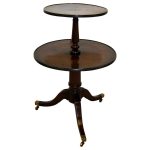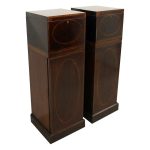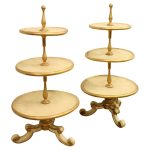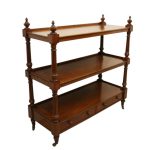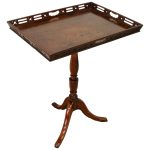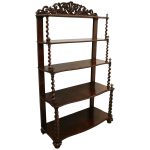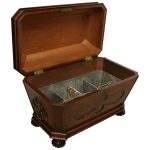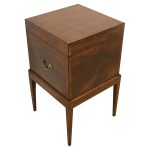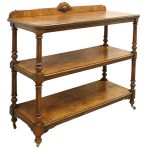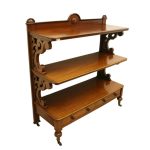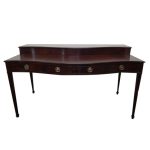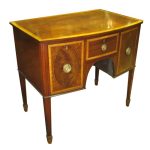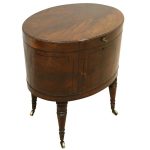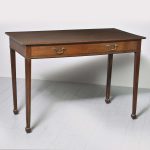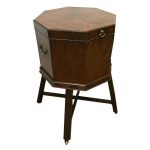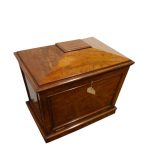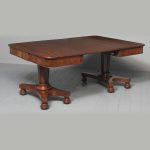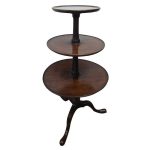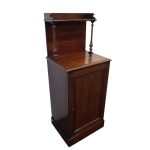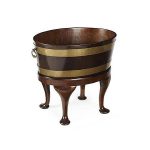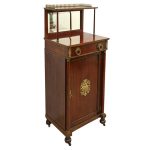Antique Dining Room Furniture: A Short History
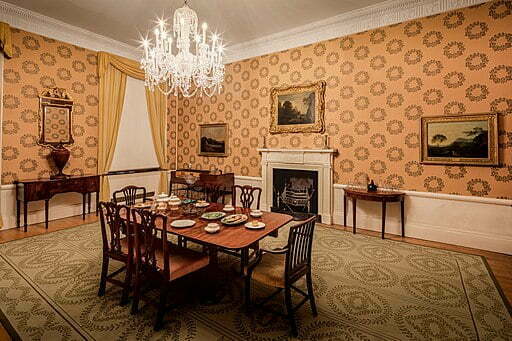
A group or family dining experience was an important feature in the wealthiest homes of Georgian Britain, with contemporary sources describing many hours spent around the dining table, and the importance of presentation in both the food and the fixtures!
The dining room was an elegant and well fitted room in the Georgian period and was adorned with quality pieces of furniture that were both stylised and highly functional.
Dumbwaiters
A dumb waiter could often be found to the side of the dining room. There are two forms of furniture known as a ‘dumb waiter’ (neither to be confused with the mechanical food lift). The Georgian iteration had revolving circular tiers on a column and would hold crockery and could also be used in the drawing room. The later rectangular dumb waiter with long, rectangular shelves was also used to hold dishes and food prior to it being served. You can see our range of dumb waiters and buffets/serving furniture here.
The dining table also had several pieces on or around it which helped the dining experience run smoothly.
Antique Coasters
Cheese coasters were used (as their name suggests) to store/hold cheese on the dining table. Their boat shaped design with scooped out centres accommodated a series of cheeses.
Wine coasters (like the one to the right) were sometimes made in mahogany and were fitted with bun feet or leather castors, which allowed the wine to be manouevred easily around the dining table without leaving any scratches. Silver or silver plated wine coasters were more common than their mahogany counterparts.
Antique Drinking Accessories
Sitting alongside the table would be a wine cooler or cellarette, with a lead lined interior which filled with ice from the ice house, kept the champagne and wine chilled. The rectangular, lockable ‘liquor case’ or guarduvin were also used to store spirits.
A common feature of Edinburgh-made Georgian brass bound wine coolers were open fretwork quarter brackets at the top of the legs and a particular inlaid design. The sarcophagus shaped wine cooler later became fashionable, and its low height allowed it to fit beneath a sideboard.
And last but no means least – where to keep your expensive and desirable silverware? Knife boxesand cutlery boxes were only owned by wealthy families in the late 18thand 19th centuries, and were often in the style of the most important designers of the day including Hepplewhite, Sheraton and Adams. They were generally made in pairs, with one placed either end of a sideboard. For those wanting to display their silverware engraved with the family crest, the lid could be left open.
It’s worth noting that most of these dining room fixtures would only be found in the wealthiest Georgian homes, as the majority of society would have instead cooked and dined around the kitchen fireplace. These Georgian dining room pieces still serve a practical purpose today, as well as being important historical reminders of the fine art of dining.
Current stock:
-

Rare, Neat-Sized George III Mahogany Table-Top Cellarette
£750 -
Sale!

Neat Sized Regency Mahogany Chiffonier
Original price was: £2,850.£2,200Current price is: £2,200. -

Mid-Victorian Scottish Four Door Mahogany Sideboard
£1,750 -

Unusual Miniature Dutch Walnut Circular Breakfast Table
£575 -

George III Brass-Bound, Oval Open Wine Cooler on Stand with Original Zinc Liner
£2,300 -

Carved Oak Pedestal Sideboard in the Style of EW Pugin
£4,800 -

Sheraton Style 2 Tier Dumb-Waiter
£525 -

William IV Neat-Sized Mahogany Cellarette in The Form of a Chest of Drawers
£775 -

Quality, Large Mirror-Back Victorian Mahogany Chiffoniere (Sideboard)
£2,950 -

George III Mahogany Inlaid Sideboard
£2,750 -

Neat Sized Solid Oak Jacobean Style Dresser
£440 -

Large Victorian Pedestal Sideboard
£2,500 -

Equestrian Themed Wall Mounted Dinner Gong
£800 -

Unusual French, Tall Inlaid Fruitwood Dresser with Lovely Colour and Patina
£3,300 -

George III Mahogany Sideboard
£3,750 -

A Neat Sized Oak Jacobean Style Dresser
£1,250 -

French Walnut Two-Part Dresser
£1,650 -

Stylish Walnut Tow Tier Trolley
£650 -

George III Mahogany Wine Cooler with Wonderful Colour and Patina
£690 -

Circular Victorian Oak Dinner Gong
£650 -

Marquetry Inlaid Marble-Top Mirror-Back Victorian Figured Walnut Sideboard/Credenza
£2,950 -

Neat Sized Regency Chiffonier
£2,650 -

George III Mahogany Butlers Tray on stand
£650 -

George III Mahogany Teapoy
£950 -

Unusual and original oak folding butlers’ tray on original stand
£775 -

George III Mahogany Tray on Brass Stand
£1,250 -

Massive Carved Victorian Walnut Wine Cooler
£3,500 -

Quality William IV Sarcophagus-Shaped Wine Cooler in Spanish Mahogany
£1,190 -

William IV Sarcophagus Shaped Wine Cooler
£1,750 -

Chippendale Style Mahogany Kettle Stand
£750 -

George III Style Mahogany and Brass Bound Wine Cooler
£1,750 -

George III Oak 2 Part Dresser
£1,950 -

A Large George III Inlaid Mahogany Sideboard
£3,750 -

A Sorrento (Dell-boy) 2 Tier Trolley
£500 -

Magnificent Victorian Pollard Oak Mirror-Backed Sideboard
£2,750 -

Jacobean-Style 19th Century Oak Two-Part Welsh Dresser
£1,590 -

French Walnut Metamorphic Buffet
£1,750 -

Solid Wood Butchers Block on Stand
£600 -

Sheraton Style Tray Top Table
£675 -

Cane Work Wine Cooler Likely by Morison or Whytock & Reid of Edinburgh
£875 -

Stylish Georgian Style Detachable Mahogany Tray and Stand
£875 -

Maple & Co Mirrored-back Sideboard
£2,250 -

Large Victoria Oak Welsh Dresser
£1,650 -

Oak Two-Part Welsh Dresser
£1,350 -

Anglo-Chinese Box on Stand
£1,250 -

Georgian Butlers Cutlery Tray
£650 -

Large Buffet by Whytock & Reid of Edinburgh
£1,600 -

Regency Inlaid Mahogany Stage-Back Sideboard
£2,200 -

George III Inlaid Mahogany Sideboard
£3,450 -

Antique Mahogany George III Style Butler’s Tray
£550 -

Antique Mahogany Oval Coffee Table
£950 -

Inlaid and Carved walnut Tazza
£325 -

Georgian Inlaid Mahogany Sideboard
£4,750 -

Antique Georgian Scottish Stage-Back Sideboard
£3,500 -

Victorian Mahogany Butlers Tray on Stand
£900 -

Antique Inlaid Mahogany Dropleaf Trolley
£630 -

William IV Mahogany Sarcophagus Cellarette
£2,250 -

George III Open Wine Cooler
£2,475 -

Vintage Italian Inlaid Walnut Trolley
£525 -

George IV Mahogany Oval Dumbwaiter
£2,500 -

Regency Mahogany Sarcophagus Shaped Wine Cooler
£2,250 -

George III Inlaid Mahogany Octagonal Wine Cooler
£1,750 -

Scottish Regency Rosewood Chiffonier
£5,250 -

George III Dome Top Wine Cooler
£1,250 -

Scottish Mahogany Sarcophagus Wine Cooler
£3,500 -

George III Inlaid Mahogany Octagonal Wine Cooler
£2,500 -

Charles II Carved Oak Cupboard
£2,250 -

Unusual Castle Design Oak Dresser
£1,500 -

Marquetry Inlaid Mahogany Dumbwaiter
£2,050 -

Victorian Inlaid Mahogany Tray on Stand
£350 -

Carved Oak Buffet
£1,250 -

George III British 3 Tier Mahogany Dumbwaiter
£2,250 -

George III Style Mahogany Dumbwaiter
£690 -

Neat Regency Rosewood Chiffonier
£2,250 -

19th Century Butlers Tray and Stand
£525 -

George III Three Tier Mahogany Dumbwaiter
£1,190 -

Mahogany Inlaid Wine Cooler
£800 -

Georgian Style Welsh Oak Dresser
£770 -

William IV Mahogany Buffet
£1,490 -

Regency Rosewood Secretaire Chiffonier
£3,750 -

George III Two Tier Mahogany Dumb Waiter
£775 -
Sale!

George III Mahogany Inlaid Vin Du Gard
Original price was: £1,950.£1,550Current price is: £1,550. -

Large William IV Mahogany Cellarette
£1,850 -

Oyster Veneered Walnut Sideboard by Gill and Reigate, London
£2,750 -

Victorian Walnut Three Tier Buffet
£1,450 -

Late Victorian Oak Three Tier Buffet
£875 -

Edwardian Mahogany Trolley
£575 -

William IV Adjustable Dumbwaiter
£1,475 -

George IV Mahogany and Ebonised Inlaid Wine Cooler
£1,450 -

Carved Oak Drop Leaf Trolley
£490 -

Victorian Oak Metamorphic Dumb Waiter
£1,450 -

George III Mahogany Two Tier Dumb Waiter
£1,390 -

Pair of George III Mahogany Dining Room Pedestals
£3,500 -

Pair of Victorian Miniature Dumb Waiters
£750 -

Victorian Mahogany Buffet / Whatnot
£1,800 -

George III Mahogany Snap Top Occasional Table
£750 -

Biedermeier Waterfall Whatnot / Buffet
£1,950 -

Regency Sarcophagus Mahogany Wine Cooler
£2,450 -

George III Mahogany Wine Cooler
£1,175 -

Mid Victorian Pollard Oak Whatnot / Buffet
£1,750 -

Victorian Mahogany Whatnot / Buffet
£1,790 -

George III Mahogany Serpentine Sideboard
£4,250 -

George III Bow Front Sideboard
£4,950 -

Late George III Large Mahogany Wine Cooler
£3,250 -

Georgian Style Spanish Mahogany Hall / Serving Table
£2,400 -

George III Octagonal Cellarette / Wine Cooler
£2,200 -

Early Victorian Mahogany Sarcophagus Cellarette
£1,790 -

William IV Twin Pillar Mahogany Dining Table
£3,750 -

George III Mahogany Dumb Waiter
£950 -

Early Victorian Ledge Back Chiffonier / Cabinet
£900 -

George II Mahogany Wine Cooler
£2,500 -

French Neat Sized Mahogany Chiffonier
£975
